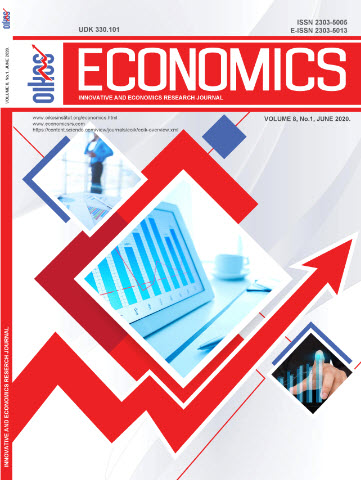CENTRAL AND SOUTH – EASTERN EUROPE BANKING SECTORS IN THE SUSTAINABLE DEVELOPMENT FUNCTION
DOI:
https://doi.org/10.2478/eoik-2020-0009Keywords:
Happiness Index, Sleep Economics, Sleep Deprivation, Inadequate SleepAbstract
Changes in banking sectors with the onset of the global financial crisis were related to: globalization, sector deregulation, technological change and financial innovation. Structural changes within banking services (at the end of the 20th century) relate to: the consolidation of banks, the merging of banking and non-banking financial institutions and their competition with one another. Significant place in the part of sustainable development belongs to bank performance, vision and mission of banks. The corporate vision of banks should be the “framework” for the future development of a bank. The corporate mission should be a “roadmap” to the realization of the bank’s vision and an expression of the business philosophy of the bank in question. It is of particular importance for the banking sectors of the CEE countries to define: the vision, the mission, the situational analysis and the planned long-term goals of the bank. With the advent of the global financial crisis, the financial activity of banks in the Central and Southeastern European region decreased, as the number of attractive fusion and acquisition banks in the region concerned was reduced.
The aim of the research is to determine the importance of the vision, mission and clearly set goals in banks, where the analysis of banking sectors in 13 countries over a period of 11 years was carried out. The analysis of GDP and its growth in the period from 2008 to 2018 indicates a dynamic growth in the countries of Central Europe and some countries of Southeast Europe. The analysis of the assets of the banking sector and its share in GDP indicates the dominant participation of the countries of Central and Southeastern Europe that are members of the European Union relative to the candidate countries for EU member states. Analysis of the banking sector of the influx countries shows that more than 70% of the banking market in Southeast European countries is influenced by foreign highly developed banking groups. Sustainable development can only be achieved through the active joint action of the banking sectors of the Central and Southeast European countries.
References
Vunjak N., Ćurčić U. & Kovačević Lj. (2013). Corporate Banking, Proleter Bečej, Faculty of Economics Subotica.
Cocris V. & Nucu E., (2013). Monetary policy and financial stability (empirical records from Central and Eastern European countries, Baltic Journal of Economics 13 (1), (75-98).
Koch W. T., & MacDonald S. S., (2003). Bank Management, Thomson - Western, New York.
Pere, E. (2015). The impact of good governance in the economic development of Western Balkan countries. European Journal of Government and Economics, Volume 4: 25-45, Retrieved from http://www.ejge.org/index.php/ejge/article/view/59/52.
Vunjak N., Radović M., Vitomir J. & Štrbo S. (2019). Corporate Finance, IRC - Center for Economic Research Subotica, Modern Business School Belgrade (MBS).
Curcic U. (2003). Managing Bank Growth and Performance (Strategic Management of Bank Value and Performance Growth), Mladost Holding, Color Print, Loznica.
Achim, V., Borlea,N.,& Mare,C. (2015) Corporate governance and business performance: evidence for the Romanian economy, Journal of Business Economics and Management, ISSN 1611-1699 / eISSN 2029-4433.
Sherstnev, M. A. (2019). World Economy, Economic Science, and Economic Policy: What Comes After the Crisis. In Sustainable Growth and Development of Economic Systems, Springer, Cham (87-100).
Andries, A.M.(2011) “The Determinants of Bank Efficiency and Productivity Growth in the Central and Eastern European Banking Systems”, Eastern European Economics,49(6), (38–59).
Dragosavac M. (2013). Impact and Consequences of the World Economic Crisis on Macroeconomic Factors in Central and Southeastern Europe (International Conference), University of Business Engineering and Management, Banja Luka.
Andries A.M. & Căpraru B., (2012)“Competition and efficiency in EU27 banking systems”, Baltic Journal of Economics 12(1), (41-60).doi: 10.1080/1406099X.2012.10840510.
Košak, M., Zajc, P. & Zorić, J. (2009) Bank efficiency differences in the new EU member states”,Baltic Journal of Economics, 9:2, (67–89).
Dragosavac M. (2019) Business performance effects on the non-performing loans (npls) level in the CEE banking sector, 5th International scientific conference corporations as multidimensional actors/entities, University of Novi Sad, Faculty of technical sciences (174-186),
Barth R., Caprio G. & Levine R.,(2004)” Bank regulation and supervision: What works best?,” Journal of Financial Intermediation, Vol. 13, (205-248),doi:10.1016/j.jf.2003.06.002,.
Buterin V.; Škare, M. & Buterin, D. (2017). Macroeconomic model of institutional reforms’ influence on economic growth of the new EU members and the Republic of Croatia. Economic Research - Економска истраживања, 30, 1: (1572–1593).
Poghosyan, T. & Poghosyan, A.(2010) ”Foreign bank entry, bank efficiency and market power in Central and Estern European Countries”,Economics of Transition, 18, No.3: (571-598). doi: 10.1111/j.1468-0351.2009.00378.
Pervan M., Pelivan I., & Arnerić J.(2017) ”Profit persistence and determinants of bank profitability in Croatia,” Economic Research- Ekonomska istraživanja, Vol. 28, No. 1, (284-298). doi link: http://dx.doi.org/10.1080/1331677X.2015.1041778.
Garciya-Marco T. & Robles-Fernandez M.D.(2013) ”Risk-taking behavior and ownership in the banking industry: The Spanish evidence”, Journal of Economics and Business, Vol. 60, no.4, (332- 354) doi:10.1016/j.jeconbus.2007.04.008,2013.
Babihuga R.,(2007) ”Macroeconomic and financial soundness indicators: An empirical investigation”, IMF working paper, no.115, (1-32).
Barjaktarović, L., Paunović, M. & Ječmenica, D. (2013) ”Development of the banking sector in CEE countries – Comparative analysis”, Central bank of Montenegro, Journal of Central Banking Theory and Practice, Vol.2 No.1. Montenegro.
Cocris V. & Nucu E., (2013). Monetary policy and financial stability (empirical records from Central and Eastern European countries, Baltic Journal of Economics 13 (1), (75-98).
Dmitrovic M., Dobrota M. & Knezevic S.,(2016) ”A statistical approach to evaluating bank productivity”, Management, 2016/75, (47-56) doi: 10.7595/management.fon.2015.0010.
Raszkovski A. & Bartniczak B. (2019). Sustainable Development in the Central and Eastern European Countries (CEECs): Challenges and Opportunities, Sustainability ,Faculty of Economics, Management and Tourism, Wrocław University of Economics, Poland.
Laidroo L., Männasoo K.,(2014) Perils of excessive credit growth: evidence from 11 new EU member states”, Baltic Journal of Economics, 1-2, (17-34).
Mano-Bakalinov, V. (2016). Trade liberalisation and economic growth in Macedonia. South East European Journal of Economics and Business. Volume 11 (2), 48-60. doi: 10.1515/jeb-2016-0010
Central Bank Publications of the analyzed countries (Slovenia, Slovakia, Czech Republic, Poland, Hungary, Croatia, Bulgaria, Romania, Serbia, Bosnia and Herzegovina, Montenegro, Macedonia and Albania) (Time period 2008-2018).
Arestis, P., Ferrari Filho, F., & Terra, F. H. B. (2018). Keynesian macroeconomic policy: Theoretical analysis and empirical evidence. Panoeconomicus, 65(1), 1-20.
Stanić. S., & Račić Ž., (2019) Analysis of macroeconomic factors effect to gross domestic product of Bosnia and Herzegovina using the multiple linear regression model, Economics – innovation and economic research, Vol 7, No 2, (91-97) ISSN 2303-5013. Available at: <http://economicsrs.com/index.php/economicus/article/view/192>. Date accessed: 13 may 2020. doi: https://doi.org/10.2478/eoik-2019-0022.
Downloads
Published
How to Cite
Issue
Section
License
Copyright (c) 2020 Oikos Institute - Research Centre

This work is licensed under a Creative Commons Attribution-NonCommercial-NoDerivatives 4.0 International License.























